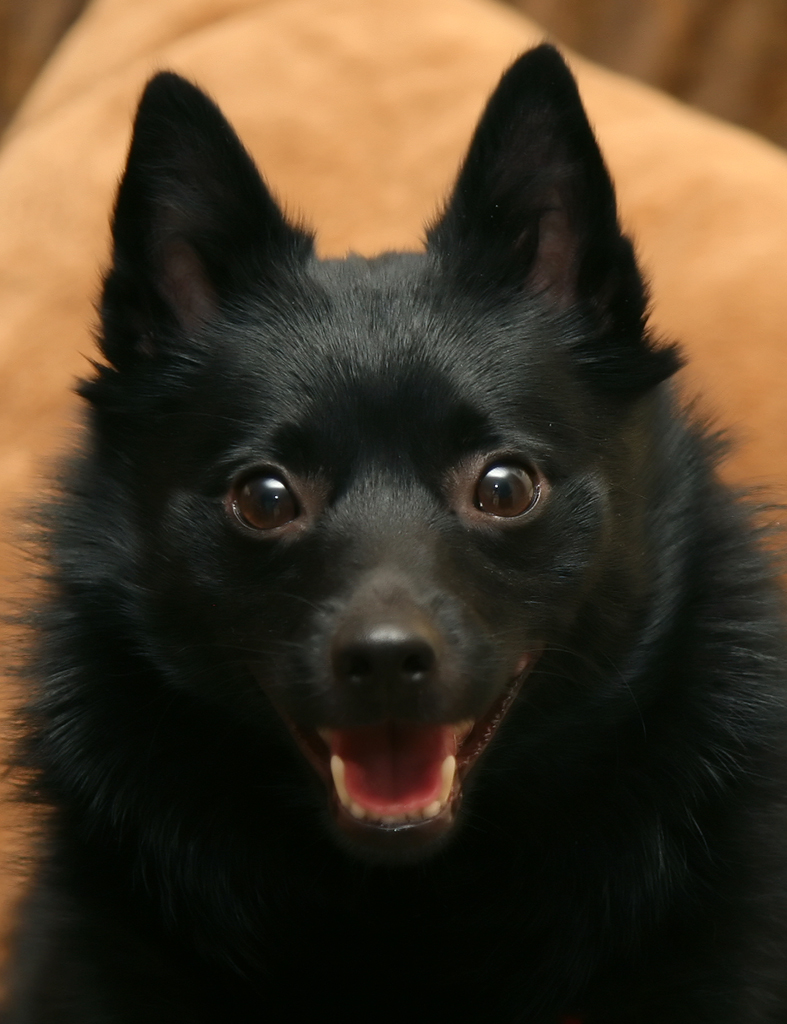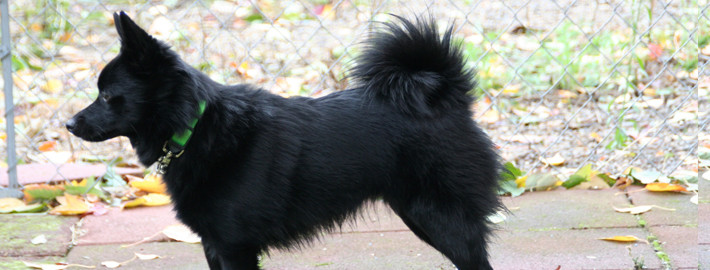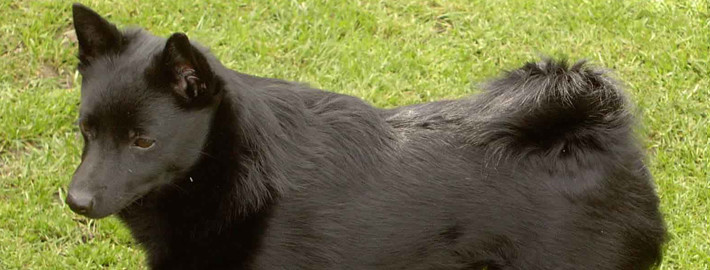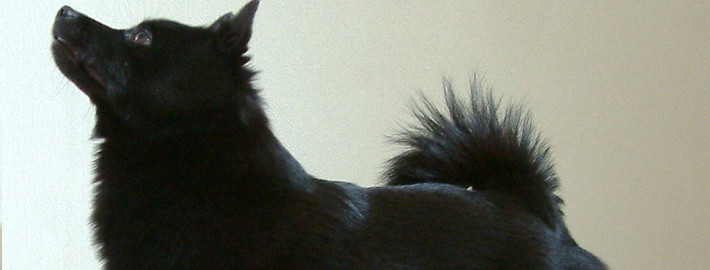What makes the Schipperke Unique?
Although the breed is not especially common in America, Schipperkes make good pets for active families that contain older children.
Breed Groups
Page Contents

Is the Schipperke Right For You?
Schipperkes adore children and are incredibly loyal to their human families. However, these canines tend to be wary of strangers and are enthusiastic barkers. They make excellent watchdogs as a result.
Owners should further note that Schipperkes have a high prey drive. This means that they enjoy chasing smaller animals and are poor choices for households that already contain pet rodents. Although many members of this breed get along with both cats and other dogs, some individuals may display aggression towards other canines.
In 5 Words
- Agile
- Faithful
- Fearless
- Curious
- Confident
Characteristics
Learn About the Schipperke
Description
General Description
Schipperkes are little dogs with sturdy, square-shaped bodies. They have a fluffy double coat that stands out in places. Members of this breed typically have an inquisitive or mischievous expressions on their faces. They also possess pointy ears that sit upright on their heads. In parts of North America, removing Schipperke puppies’ tails is a common practice because these appendages will otherwise be a variety of different lengths. Of course, owners living in places where docking is illegal will be obligated to leave the aforementioned feature in its natural state.
Size
Males of this breed stand approximately 13.2 inches (33.6 centimeters) tall and females are somewhat shorter at 12.3 inches (31.2 centimeters) in height. Schipperkes of both genders typically weigh between 10 and 16 pounds (4.5 and 7.2 kilograms).
Coat
As was previously stated, these dogs have a glossy double coat. The lengthy outer layer is somewhat coarser than the velvety soft inner layer. Schipperkes also have longer fur on their necks, backs, and posteriors. Members of this breed are either black or blonde in color.
Short History of the Schipperke
Created in Belgium in the late 1600s, the Schipperke first served its owners as a watchdog and as a companion. This breed is a downsized version of the Leauvenaar sheepdogs and does not contain any Spitz ancestry. For many years, members of this breed worked on canal boats where they earned the nickname of ‘little captains’. Schipperkes were also popular pets in craftsmen’s households. The earliest show for the breed was held in 1690 in Brussels. By 1888 a breed club had been formed and these dogs had made their way to America.
Temperament
Schipperkes typically have lively dispositions and an inquisitive nature. They like nothing better than to be busy, which can often lead to them being perceived as a mischievous breed. After all, there is probably a reason these dogs have obtained the nickname ‘little black devils’.
Schipperkes adore children and are incredibly loyal to their human families. However, these canines tend to be wary of strangers and are enthusiastic barkers. They make excellent watchdogs as a result.
Owners should further note that Schipperkes have a high prey drive. This means that they enjoy chasing smaller animals and are poor choices for households that already contain pet rodents. Although many members of this breed get along with both cats and other dogs, some individuals may display aggression towards other canines.
Caring for Your Schipperke
General Health
Schipperkes tend to live between 13 and 15 years on average. Due to their thick coats, these dogs have a low heat tolerance and they are probably not a good breed choice for folks living in warm environments. Owners should also be aware that eye and hip problems are the most common health concerns for members of this breed. Other ailments that Schipperke are prone to include epilepsy, hypothyroidism, mucopolysaccharidosis type IIIB, entropion, and distichiasis.
Care
Daily
These dogs need at least a half hour of exercise per day. They should remain on their leashes when they are being walked rather than being allowed to roam about freely.
Weekly
At least once a week, these dogs will need to be combed. It is recommended that owners use a brush with firm bristles in order to get the best results. Owners may also want to clean their dog’s teeth several times a week to encourage fresh breath and prevent tooth decay.
Monthly
Parasite prevention medications are recommended for all pets and these products are typically administered on a monthly basis.
Grooming & Bathing
This breed has very basic grooming needs. The dogs only need an occasional bath but they can just as easily be dusted with dry shampoo. Their nails should also be kept clipped. Those who plan on showing their dogs can additionally trim the hair on their dog’s feet if they wish to do so.
Schipperkes are light shedders for much of the year but they do go through periods where they shed their entire coat in about a week and a half. During this time, owners will need to brush their dog several times a day. It is also a good idea to wash pets when they are shedding heavily in order to keep households from becoming inundated with fur.
Exercise & Training
Schipperkes are an exceptionally active breed. When given appropriate amounts of exercise, these dogs will behave perfectly well indoors. However, members of this breed also love running and digging. Apartment dwellers can solve this dilemma by taking their Schipperkes to the dog park so that they can safely indulge in their favorite pastimes. Of course, an enclosed yard makes an even better place for these dogs to play but electronic fences will not be able to contain them.
Schipperkes are quite independent minded and not always inclined to listen. Members of this breed often seem to debate if they should obey the instructions they are given or do what they like. These dogs can also develop incredibly undesirable behaviors if they are allowed to do as they see fit. Therefore, Schipperkes are not recommended for first time pet owners.
However, Schipperkes are intelligent dogs and not unwilling to learn. Many members of this breed do well in both agility and obedience competitions. While owners may eventually progress that far with their pets, basic obedience training is a must for these dogs. Lessons should be kept interesting and short in order to obtain good results. Using rewards to motivate these dogs also helps. Members of this breed further benefit from consistent leadership and well-defined limits.
Schipperkes particularly enjoy barking and will continue to do so if they are not taught from a young age that they should quiet down after alerting their owners when new people arrive. Housebreaking can likewise be problematic for some members of this breed. Therefore, unsupervised puppies should be kept in their kennels until they are completely housetrained to keep them from soiling the floor. Schipperkes will also require early socialization to keep them from becoming unduly suspicious of unfamiliar people.











